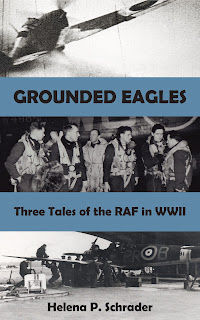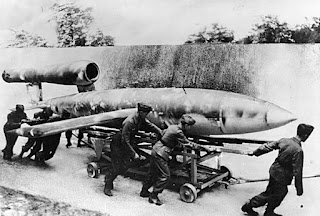Attacking Hitler's "Wunderwaffen" (V1, V2, V3)
Hitler's Wonder or Vengeance Weapons (Wunderwaffen or Vergeltungswaffen) killed roughly 9,000 civilians in the UK and damaged half the housing in the British capital. The V1 was the first "cruise missile" and the V2 was the first rocket-delivered explosives in history. While few believe they alone could have altered the outcome of the war, the damage they inflicted called for a vigorous response. Yet the RAF's options against these new weapons were limited.
Just one week after D-Day, the first of Hitler's Vengeance weapons struck British soil. They instantly killed 6, injured 30 and made 200 people homeless in a single unopposed attack that risked not a single German life. Three days later, V1s had taken 499 lives and injured 2,000 while 137,000 buildings had been damaged.
The V1 was a drone, or a flying bomb as it was called at the time, roughly the same size as contemporary fighters, but unmanned. They were also very crudely controlled. Essentially, they were pointed in the generally right direction and flew until their fuel ran out. Then they crashed out of the sky to harm whatever was below them, whether it was militarily significant or not.
Individually, the V1s were no match for a British fighter. Their cruising speed of 150 mph was only about half of that of the fighters of the era. They flew at altitudes of just 2,000 to 3,000 feet. If intercepted, the pilots of Fighter Command had little difficulty shooting them out of the sky since they could neither maneuver nor shoot back. Fighter Command and anti-aircraft batteries together accounted for the destruction of 3,463 V1s, or slightly more than one third of them. The main problem was intercepting them in the first place.
Precisely because they were being lobbed across the channel day and night individually and without any specific target, it was very hard for radar to detect them in time to scramble fighters for an intercept. Furthermore, because they were coming in individually all heading roughly for London, alarms were incessant. At the peak of the offensive roughly 100 V1s were aimed at London every day. It was impossible to take shelter all the time and still get anything done, so people fatalistically ignored the warnings -- thereby increasing the casualties caused.
Which didn't mean that civilian morale was not affected. More children and old people were evacuated from London in the V1 summer (June - August 1944) than had been sent out in the first months of the war. Many other workers tried to at least sleep outside of London, and the surrounding suburbs were flooded with Londoners seeking temporary relief from the threat and the stress.
Attempts to bomb the launch sites were the obvious solution. Yet this proved to be far more difficult than it sounded. The launch sites, unlike the research facilities, were small and readily camouflaged. Destroying them required much greater bombing accuracy than most RAF squadrons could deliver. The locations were also well-defended, which could make attacks by bombers very costly. Ultimately, it was the advancing Allied armies, fighting their way out of Normandy that overran the V1 launch sites thereby putting an end to the menace. The last V1 launch site fell to the Allies in October 1944.
But by then the V2s were already being flung at Britain. The V2s were inherently more dangerous. The V2s were real rockets with a range of 225 miles, which fell from 60 to 70 miles high at speeds of 3,600 mph -- faster than the speed of sound. They came in too fast to set off air raid warnings, and the destruction they caused was unprecedented -- an entire block or row of houses could be turned into rubble in an instant. Collateral damage stretched from the point-of-impact in a quarter-mile radius.
My novels about the RAF in WWII are intended as tributes to the men in the air and on the ground that made a victory in Europe against fascism possible. 617 Squadron is featured in "Moral Fibre" and many of the squadrons famous raids -- but not their debut dambuster raid -- are described in it.
Riding the icy, moonlit sky,
they took the war to Hitler.
Their chances of survival were less than fifty percent.
Their average age was 21.
This is the story of just one bomber pilot, his crew and the woman he loved.
It is intended as a tribute to them all.
or Barnes and Noble.

"Where Eagles Never Flew" was the the winner of a Hemingway Award for 20th Century Wartime Fiction and a Maincrest Media Award for Military Fiction. Find out more at: https://crossseaspress.com/where-eagles-never-flew
For more information about all my aviation books visit: https://www.helenapschrader.com/aviation.html









Infantry . . . the Queen of Battle.
ReplyDeleteVery educational and interesting, Professor. Thanks!